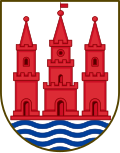Skanderborg
| Skanderborg | ||||
|
||||
| Basic data | ||||
|---|---|---|---|---|
| State : |
|
|||
| Region : | Midtjylland | |||
|
Municipality (since 2007) : |
Skanderborg | |||
| Coordinates : | 56 ° 2 ' N , 9 ° 56' E | |||
| Founded: | 12th Century | |||
|
Population : (2020) |
19,525 | |||
| Area : | 143.2 km² | |||
| Population density : | 136 inhabitants per km² | |||
| Postal code : | 8660 Skanderborg | |||
| Sister cities : |
|
|||
| Website: | www.skanderborg.dk | |||
 The castle church |
||||
Skanderborg , a Danish town , is located in East Jutland between Horsens in the south and Aarhus in the north on Lake Skanderborg.
geography
The topography of Skanderborg is determined by the late Ice Age moraine landscape of Jutland . Small lakes and partly wooded hills line the districts. In the southern part of the municipality is the highest and third highest natural elevation in Denmark , Møllehøj (170.86 m above sea level) and Ejer Bavnehøj (170.35 m), to the west of the municipality is Himmelbjerget (147 m). Yding Skovhøj (170.77 m) is located in the neighboring municipality of Horsens . Tradition has it that there is a sacrificial site from pre-Christian times in the nearby floodplain valley of Illerup Ådal .
history
Nearby are the sites of the Ringkloster from the Mesolithic , Alken Enge and Illerup Ådal from the Iron Age and the rune stones from Sønder Vissing .
The Danish imperial chronicle mentions that the Danish king Waldemar IV defeated the rebellious Jutlanders around Niels Ebbesen with his army near Skanderborg in the winter of 1340 , Ebbesen was killed in the battle.
As early as 1166, a group of Cistercian monks from Vitskøl monastery founded the monastery Øm on the island of Den kære Ø (the dear island). A church and several massive residential and storage buildings made of field stones and bricks were surrounded by a curtain wall with gate tower, palisades and moats. The draining of meadows and clearing created an agricultural basis, which farmers from the surrounding areas soon cultivated. The monastery existed until the Reformation in 1536, Jens - the last abbot - handed over the stately property as well as the church and the dormitory of Emsborg in 1560 to his sovereign, King Frederik II. The monastery buildings and the now vacant church were removed the king erect a fort-like castle building.
The place Skanderborg had developed into a craft and trading settlement near the monastery. Frederik II granted it city rights in 1583 and completed the castle.
Christian IV was introduced to shipping here and Frederick IV married Sophie Reventlow here .
As part of a new structural reform, the municipalities of Galten , Hørning and Ry merged with Skanderborg (1970-2006; 143.2 km²) on January 1, 2007 . The total area of the new Skanderborg municipality is now 436.1 km².
Development of the population (January 1st) :
|
|
|
A town partnership with the German town of Eisenach has existed since 1993 .
traffic
Skanderborg is accessed both by the important railway from Fredericia to Aarhus and by the Jutland north-south motorway ( E45 ), the continuation of which is the German A 7 . The area of the city of Skanderborg is 143.2 km².
Culture and sights
Since 1980 the music event " Skanderborg Festival " has been held annually in a forest near Skanderborg . It is known as "Denmark's most beautiful festival".
The rune stones from Sønder Vissing are not far from the local church . South of the town center, near the lake, is the bunker museum in a former command bunker of the German air force .
Personalities
- Princess Anna of Denmark (1574 1619), wife of James I, Queen of England, Scotland and Ireland
- Carl Rosenberg (1829–1885), publicist and historian
- Uffe Elbæk (* 1954), politician
- Poul Erik Tøjner (* 1958), museum director and art critic
- Kasper Irming Andersen (* 1986), handball player
- André Steensen (* 1987), racing cyclist
gallery
Skanderborg Castle ( Laurids de Thurah )
literature
- Lars Lassen (Ed.): Skanderborg Kommune . 6th edition. Skanderborg 2007, ISBN 87-991139-2-9 , pp. 264 (Danish).
Individual evidence
- ↑ a b Statistics Banks -> Befolkning og valg -> BY1: Folketal January 1st efter byområde, alder og køn (Danish)
- ↑ www.statistikbanken.dk → Befolkning og valg → Folketal → Table BEF4A: Folketal pr. January 1st demands på byer (AFSLUTTET)
Web links
- Official website of the municipality (Danish)




